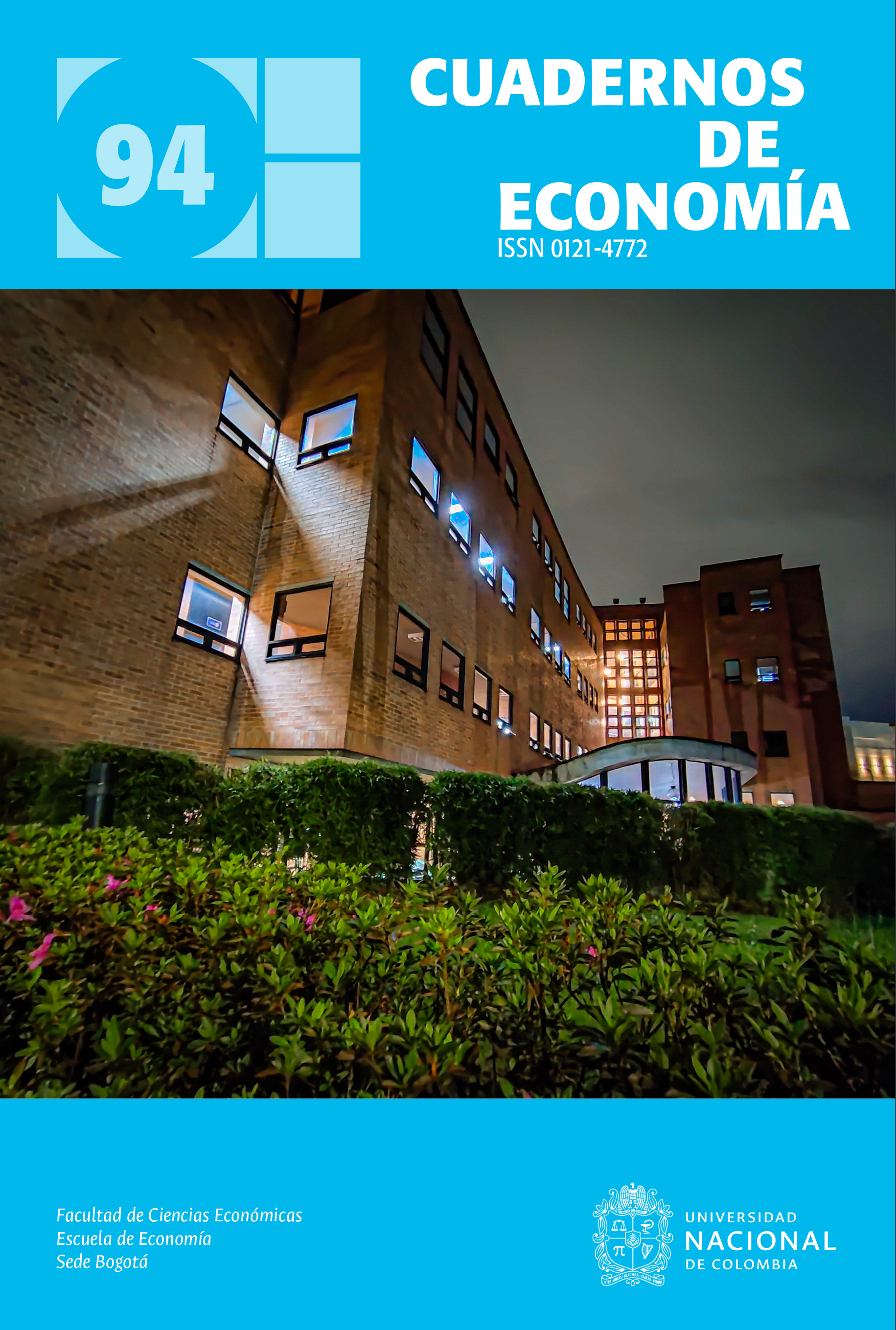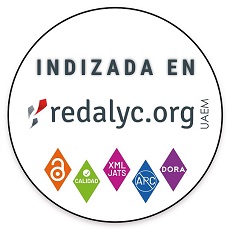Precio mundial del café y su efecto en el precio interno para países latinoamericanos
World coffee price and its effect on the domestic price for Latin American countries
DOI:
https://doi.org/10.15446/cuad.econ.v44n94.108187Palabras clave:
Café, Colombia, Brasil, Causalidad de Engle y Granger, Funciones impulso-respuesta (es)Coffee, Colombia, Brazil, Engle and Granger causality, Impulse-response functions (en)
Descargas
El estudio determina la relación existente entre el precio internacional del café arábigo y el precio interno en los mercados de países latinoamericanos entre 1991 y 2019. Para ello se utilizan tests de raíces unitarias de Dickey y Fuller; tests de causalidad de Engle y Granger; cointegración y funciones de impulso-respuesta. Los resultados obtenidos evidencian que existe una relación de largo plazo entre el precio internacional del café y los precios para los cinco países latinoamericanos estudiados. En conclusión, los mercados locales tardan aproximadamente 5 meses o menos para absorber los cambios en el precio internacional.
The study determines the relationship between the international price of Arabica coffee and the domestic price in the markets of Latin American countries between 1991 and 2019. For this, Dickey & Fuller unit root tests, Engle, and Granger causality tests, cointegration and impulse response functions. The results obtained show that there is a long-term relationship between the international price of coffee and the prices for the five Latin American countries studied. In conclusion, local markets take approximately 5 months or less to absorb changes in international prices.
Referencias
1. Addison, T., Ghoshray, A., & Stamatogiannis, M. P. (2016). Agricultural Commodity Price Shocks and Their Effect on Growth in Sub-Saharan Africa. Journal of Agricultural Economics, 67(1), 47-61. https://doi.org/10.1111/1477-9552.12129
2. Agosin, M. R., & Ffrench-Davies, R. (1993). La liberalización comercial en América Latina. Revista de la Cepal, 50, 41-62.
3. Alonso, J. C., & Estrada Nates, D. (2016). El precio mundial del café y su efecto en el precio minorista del café para las cinco ciudades principales de Colombia. Revista Finanzas y Política Económica, 8(2), 379-399. https://doi.org/10.14718/revfinanzpolitecon.2016.8.2.8
4. Alonso, J. C., & Gallego, A. (2010). Integración de los precios en los canales minorista y mayorista arroz, papa y fríjol en la ciudad de Cali. Economía, Gestión y Desarrollo, 10, 79-96.
5. Bohl, M. T., Gross, C., & Souza, W. (2019). The role of emerging economies in the global price formation process of commodities: Evidence from Brazilian and U.S. coffee markets. International Review of Economics and Finance, 60, 203-215. https://doi.org/10.1016/j.iref.2018.11.002
6. Cano, C., Vallejo, C., Caicedo, E., Amador, J., & Tique, E. (2012). El mercado mundial del café y su impacto en Colombia (Borradores de Economía). Banco de la República.
7. Chen, B., & Saghaian, S. (2016). Market integration and price transmission in the world rice export markets. Journal of Agricultural and Resource Economics, 41(3), 444-457.
8. Darbandi, E. (2018). Price transmission analysis for Nicaragua rice market. International Journal of Food and Agricultural Economics (IJFAEC), 6(1), 85-94. http://ageconsearch.umn.edu
9. Dickey, D. A., & Fuller, W. A. (1981). Likelihood ratio statistics for auto-regressive time series with a unit root. Econométrica, 49(4), 057-1072.
10. Engle, R. F., & Granger, C. W. (1987). Co-integration and error correction: representation, estimation, and testing. Econométrica, 55(2), 251-276.
11. Galvez-Soriano, O., & Cortés, M. (2021). Is there a pass-through from the international coffee price to the Mexican coffee market? Studies in Agricultural Economics, 123(2), 86-94.
12. Ghafoor, A., Mustafa, K., Mushtaq, K., & Abedullah, A. (2009). Cointegration and Causality: An Application to Major Mango Markets in Pakistan. The Lahore Journal of Economics, 14(1), 85-113. https://doi.org/10.35536/lje.2009.v14.i1.a4
13. Ghoshray, A., & Mohan, S. (2021). Coffee price dynamics: An analysis of the retail-international price margin. European Review of Agricultural Economics, 48(4), 983-1006. https://doi.org/10.1093/erae/jbab027
14. Greb, F., Jamora, N., Mengel, C., Von Cramon-Taubadel, S., & Würriehausen, N. (2012). Cereal price transmision from international to domestic markets in Africa. African Development Bank Group, 1-30. https://www.afdb.org/en
15. Greb, F., Jamora, N., Mengel, C., Von Cramon-Taubadel, S., & Würriehausen, N. (2016). Price Transmission from International to Domestic Markets. World Bank.
16. Hundie, S. K., & Biratu, B. (2022). Response of Ethiopian coffee price to the world coffee price: Evidence from dynamic ARDL simulations and nonlinear ARDL cointegration. Cogent Economics & Finance, 10(1), 2114168.
17. Jaramillo-Villanueva, J. L., & Benítez-García, E. (2016). Transmisión de precios en el mercado mexicano e internacional de café (Coffea arabica L.): un análisis de cointegración. Agrociencia, 50(7), 931-944.
18. Jaramillo-Villanueva, J. L., & Palacios-Orozco, A. (2018). Transmisión de precios vertical y especial en el mercado mexicano e internacional de leche. Revista Mexicana de Ciencias Pecuarias, 623-642. https://doi.org/10.22319/rmcp.v10i3.4806
19. John, A. (2014). Price relations between international rice markets. Agricultural and Food Economics, 2(1), 1-16. https://doi.org/10.1186/2193-7532-2-1
20. Krivonos, E. (2004). The impact of coffee market reforms on producer prices and price transmission. Available at SSRN 610401. http://econ.worldbank.org
21. Kuiper, W. E., Lutz, C., & Van Tilburg, A. (2003). Vertical price leadership on local maize markets in Benin. Journal of Development Economics, 71, 417-433.
22. Lee, J., & Gómez, M. I. (2013). Impacts of the End of the Coffee Export Quota System on International-to-Retail Price Transmission. Journal of Agricultural Economics, 64(2), 343-362. https://doi.org/10.1111/j.1477-9552.2012.00372.x
23. Maya, G. (1991). Agricultura, proteccionismo e industrialización: América Latina y mercado mundial. Ensayos de Economía, 2(3), 49-84. https://revistas.unal.edu.co/index.php/ede/article/view/23651
24. Mbowa, S., Odokonyero, T., & Munyambonera, E. (2014). The potential of coffee to uplift people out of poverty in Northern Uganda. EPRC Research Reports, 11, 1-85.
25. Musumba, M., & Gupta, R. Sen. (2013). Transmission of World Prices to Ugandan Coffee Growers in a Liberalised Economy. Development Policy Review, 31(2).
26. Newman, S. (2008). The role of international commodity exchanges in the formation and transmission of prices and price risk along international coffee chains. NCCR Trade Regulation, Swiss National Center of Competence in Research Center, Working Paper, (2008/12).
27. Organización Internacional del Café (OIC) (2019). Coffee Development Report 2019: Growing for Prosperity Economic Viability as the Catalyst for a Sustainable Coffee Sector.
28. Organización Internacional del Café (OIC) (2021). Historical Data on the Global Coffee. Trade Statistics Data, Exports - Calendar Year. https://www.ico.org/new_historical.asp?section=Statistics
29. Organización Internacional del Trabajo (OIT) (2022). ¿Cómo cosechar trabajo decente en el sector cafetero colombiano? https://www.ilo.org/es/resource/news/como-cosechar-trabajo-decente-en-el-sector-cafetero-colombiano
30. Revista Portafolio (2019). Caída de los precios del café, un sabor amargo para los caficultores. https://www.portafolio.co/economia/caida-de-los-precios-del-cafe-un-sabor-amargo-para-los-caficultores-528099
31. Stock, J. H., & Watson, M. W. (2001). Vector Autoregressions. Journal of Economic Perspectives, 15(4), 101-115. http://www.jstor.org/stable/2696519
32. Trejos, R. A., & Santana, C.A.M. (1991). Apertura económica: características e implicaciones para el sector agroalimentario en América Latina y el Caribe. Serie Documentos de Programas, 24, 89-94.
33. Vollrath, T., & C. Hallahan. (2006). Testing the integration of U.S. Canadian meat and livestock markets. Can. J. Agr. Econ, 54, 57-79.
Cómo citar
APA
ACM
ACS
ABNT
Chicago
Harvard
IEEE
MLA
Turabian
Vancouver
Descargar cita
Licencia
Derechos de autor 2025 Cuadernos de Economía

Esta obra está bajo una licencia internacional Creative Commons Atribución-NoComercial-SinDerivadas 4.0.
Cuadernos de Economía a través de la División de Bibliotecas de la Universidad Nacional de Colombia promueve y garantiza el acceso abierto de todos sus contenidos. Los artículos publicados por la revista se encuentran disponibles globalmente con acceso abierto y licenciados bajo los términos de Creative Commons Atribución-No_Comercial-Sin_Derivadas 4.0 Internacional (CC BY-NC-ND 4.0), lo que implica lo siguiente:





















